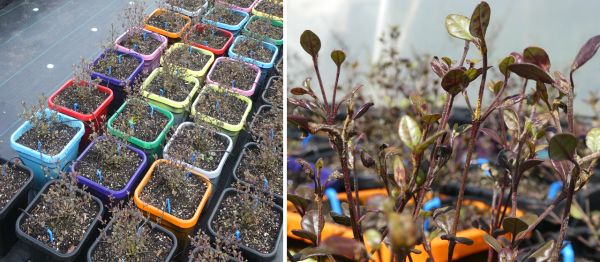Report on fungicide management for myrtle rust in nurseries released
A report titled “Risk-based fungicide management for myrtle rust in nurseries” is now available on the MPI-run myrtle rust website. We talked with Rob Beresford about the details of the report and what this might mean for myrtle rust management in nurseries.

Potted Lophomyrtus plants (left) and myrtle rust symptoms (right) in a fungicide trial at Plant & Food's Pukekohe Research Station.
The research behind this report was designed to help guide New Zealand Plant Producers Incorporated (NZPPI) in structuring an approach for fungicide use against myrtle rust in nurseries, including guidelines for preventing the development of fungicide resistance. Researchers at Plant & Food Research compared the efficacy of seven commercial products under different application regimes during high-risk and lower-risk seasons.
They found that myrtle rust control and growth flush protection were greatest for the demethylation inhibitors (DMI) triadimenol (Vandia®) and myclobutanil (Validus®). They also found that less spraying was required in lower risk seasons than in higher risk seasons to achieve the same level of protection. Furthermore, alternating products is recommended to prevent fungicide resistance.
Rob Beresford, the lead author of the report, worked with NZPPI to include information from this report in a series of workshops in October. The workshops consisted of practical sessions on myrtle rust and its management in the nursery. These included how-to sessions on using the myrtle rust weather-risk tool in the NZPPI Plant Disease Management Platform alongside the NZPPI protocols; managing the different myrtle species with their different susceptibilities; and applying non-chemical methods to reduce disease pressure.
The report comes with a strong disclaimer that the information is intended to support myrtle rust control by trained professionals in nurseries only. It also does not seek to promote fungicide use in the natural estate or home gardens as the risks of fungicide use to human, animal and environmental health need to be properly managed.
“We certainly don’t want people just going and spraying in the natural environment,” says Rob. “If you read the safety datasheets that go with each fungicide, you probably wouldn’t even dream of blanketly using them because of the human toxicology and the environmental toxicology.”
This doesn’t mean that there aren’t situations where the judicious application of fungicides could be useful. Rob is hopeful that this report will be the starting point of understanding how and where the calculated use of fungicides could do more good than harm.
“There are communities with plants that are badly infected by myrtle rust,” says Rob. “We’re transferring the knowledge from the report into other situations where feasible.”
For example, Rob and the team in partnership with Auckland Council are involved with efforts where fungicides are being used to control disease impacts on reproductive structures on isolated populations of rōhutu and swamp maire. The hope is the fungicides allow the production of fruit and potentially viable seeds.
Rob is also hopeful that the groundwork laid by this report will lead to guidance for home gardeners in the future.
“There are some products that people can buy from garden shops that can be very effective against myrtle rust,” says Rob.
Any advice provided to gardeners would need to include the risks of fungicide use, from health to resistance, and the recommended level of training for safe use.
“While anyone can buy fungicides from garden supply shops without a Growsafe Approved Handler Certificate, Growsafe Basic training is still recommended,” says Rob.
For more information about Growsafe agrichemical training, visit their website.
The NZPPI Plant Disease Management Platform can be accessed here.
